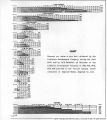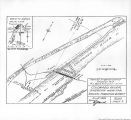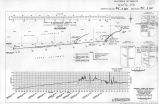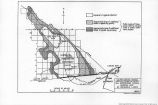| OCR Text |
Show THE ALL-AMERICA27 CANAL. 25 in suspension is about 196,700,000 tons, which at 100 pounds to the cubic foot, represents about 90,000 acre-feet of compactly deposited dry material. This does not include the river's bottom or bed load of sand, concerning which little is known other than that the river at its high stages occasionally makes rapid changes in depth and that the bottom, being loose sand, yields readily to the erosive force of the water. The studies which have been made in the Imperial Canal indicate that at an annual discharge of about 2,000,000 acre-feet the average bed load of the canal has been at least 190,000 cubic yards per month, or about 2,280,000 cubic yards per year. It will be safe and conservative to assume that the river has a bed load at least as many times greater than this as its annua.1 flow is greater. Accepting the records of the United States Geological Survey, the river's annual discharge may be placed at about 17,000,000 acre-feet, or 8.5 times the amount diverted into Imperial Canal. The bed load of the river may therefore be estimated at not less than 8.5 times 2,280,000 cubic yards, or about 19,500,000 cubic yards, or 12,000 acre-feet. The combined load, in suspension and pushed along the bottom, is therefore equivalent to an average annual deposit of at least 102,000 acre-feet, or enough material to cover 158 square miles 1 foot deep. In making this estimate it has been assumed that the average weight of 1 cubic foot of dry deposit is 100 pounds. This is based on recent careful determinations of the amount of material in a cubic foot of deposit taken from the bed of Imperial Canal. It is quite possible that this assumption is somewhat in excess of the average weight of the top layer of ground in the delta, but is likely to represent fairly the average weight when the great bulk of the river's deposits, including what lies below the surface layer of soil is considered. The all-American canal project is for the irrigation of an area of such large extent that when the lands commanded by it, together with those of the Yuma project, are all under cultivation the entire natural flow of the river would be diverted at Laguna Dam for use on both sides of the river during an average of at least one month per year and in some years, as in 1902, 1903, 1904, 1910, 1915, and 1918, from two to six months. At such times, until conditions are modified by storage, water would not be available for desilting operations without a reduction of the diversions to the detriment of the irrigators; but desilting is essential in order that as little as possible of the river's bed load of sand may get into the canal systems and that the suspended load in the waters of the canals be kept at a minimum. During the months when the irrigation demand is equal to or exceeds the quantity of water in the river at the Laguna Dam there is then urgent need for water from a stored supply to make up the |
| Source |
Original book: [State of Arizona, complainant v. State of California, Palo Verde Irrigation District, Coachella Valley County Water District, Metropolitan Water District of Southern California, City of Los Angeles, California, City of San Diego, California, and County of San Diego, California, defendants, United States of America, State of Nevada, State of New Mexico, State of Utah, interveners] : California exhibits. |




































































































































































































































































































































































































